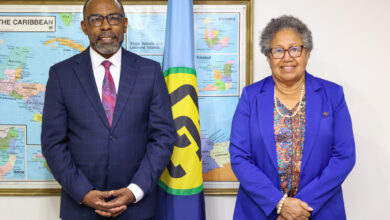|
When my colleague, Patsy Wyllie, Chief Health Educator, at the Ministry of Health asked if I would do the feature address this morning, I did not immediately agree. I thought to myself: What could I say to an audience such as this, comprising persons whom I am sure could teach me a thing or two? I think Patsy was challenging me to put my money where my mouth is, since she has been so often been on the receiving end of my arguments for increased and improved programmes, as we grapple with the problems of Substance Abuse. So here I am.
I am a Social worker, with some experience in counselling substance abusers among others, and as I wrote this address, those individuals and families, affected both directly and indirectly by substance abuse are before me. I must confess therefore that my interests are skewed towards the demand reduction response to Substance Abuse., and this address will attempt to have you look at some of the issues at the micro level, the individual level, even as you contemplate policy development at the national level during this workshop. I am told that the countries represented here, the Bahamas, Belize and St. Vincent and the Grenadines, are looking towards creating or improving their National Drug Plans. I thought that I would use this opportunity to remind us why we need to implement these plans. Lest we forget, the plans and strategies; the data collection; the alternative cultivation projects; the eradication programmes; the changes in the judicial and legislative system, should impact the country at the individual, the family, the community level. Why is substance abuse such a part of our National consciousness? Why all of this effort? There is a growing regional and international concern firstly about the illicit drug cultivation and trafficking, in the Caribbean. Drug trafficking and its attendant financial crimes continue to be one of our biggest challenges; and secondly, regarding drug use and abuse in the region: substance or drug use, dependence and abuse cuts across barriers of class, race, culture and nationality, and a high price is paid in personal, mental and physical health. In looking at substance abuse, we have to look at related areas of impaired functioning such as employment status, and family and social relations. Persons can abuse both legal and illegal drugs. It is certainly legal to purchase and use alcohol and tobacco, and when a doctor prescribes medication this too is legal. However in all three cases abuse or dependence / addiction is possible. The United Nations Office on Drugs and Crime (UNODC) and the World Health Organisation (WHO, 2008), have stated that substance abuse and dependence is a public health, developmental and security problem in our countries. Drug Dependence is a life threatening and often disabling disease that has a devastating impact not only on afflicted individuals, but also on their relatives and the other people, who often bear the burden of costs and suffering associated with drug dependence. Ultimately the drain on the national purse can be horrendous, especially for struggling economies such as those in our region. All drugs of abuse cause some form of intoxication, which interferes with judgment and increases the likelihood of risky sexual behaviours. This, in turn, contributes to the spread of other diseases such as HIV/AIDS, Hepatitis B and C, and other sexually transmitted diseases. Under the caption” Risky Behaviour of Youth costing Caribbean Governments” Caribbean Net News January 22, 2010, quoted a study done by the CARICOM Commission on Youth development in which they cited that it cost US $2000 for every pregnant teen and, US $17m per year HIV/ AIDS. A comparative study of drug use among Secondary School students in the Caribbean in 2007, commissioned by CICAD, found that the age of students’ first use of marijuana and alcohol ranged from 11-13 years. I would welcome a correction when I state that the population of our prisons, and Mental Institutions have increased due to drug related issues…Both the increase in drug use and abuse and in drug trafficking. Research has shown that there are links between drug use and crime. Offences are committed as part of the illicit drug trade. We have all heard of persons, young and old who have become frequent fliers as they act as couriers in the drug trade, willing to risk their life and liberty. Other crimes such robberies and prostitution, are committed, as individuals support their drug taking habit. Others engaged in drug –induced aggressive and violent behaviours. Drug abuse and mental disorders often co-exist. In some cases, mental diseases may precede addiction; in other cases, drug abuse may trigger or exacerbate mental disorders. The ‘duality’ of the condition impacts negatively on maintenance of sobriety. Even if the clients are sober, they must still cope with other emotional trauma. Sometimes these symptoms can be so serious and debilitating that the client resorts to using substances again co-occurring disorders can also be physical. Estimates are that three out of ten people with substance abuse problems have an underlying mood or anxiety problems as well (Winter,1993). A person who is a habitual user of substances loses the ability to think and function properly. This person may feel sad, hopeless and guilty, and sleep and appetite may be affected. This person may present as ‘depressed,’ and these symptoms mimic the symptoms of substance abuse making it difficult to differentiate between the two presenting problems. Conversely, persons with psychiatric problems are more at risk of becoming substance abusers ( Winter, 1993). Such persons with a psychiatric disorder may drink or take other drugs to alleviate the pain, as drugs alter mood. The Joint UNODC/WHO Action Programme Report further states that the costs to modern societies concerning the consequences of drug use and dependence , in relation to crime and security measures, health, problems and underdevelopment are difficult to accurately calculate, but existing estimates of economic costs of drug use and dependence amount to 2% of GDP in some countries.” This is agreed to in St. Vincent and the Grenadines Annual Report (2009) of the National Drug Information System. This Report concurs that there is no qualitative data to determine the impact of the illicit drug trade. In addition to CARICOM, we in the Caribbean are part of several international and Regional bodies, all of whom are working to come up with solutions to the drug problems, at policy levels, demand side, supply side , interdiction, and training. For example: The Organization of American States (OAS) primarily through the Inter American Drug Abuse Commission (CICAD), United Nations Office on Drugs and Crime (UNODC), World Health Organization (WHO), the NGO Committee on Narcotic Drugs, and European Union (EU) through the European Development Fund(EDF). We countries participate in the Multilateral Evaluation Mechanism (MEM) and have formed National Drug Information Systems in an effort to document and monitor our responses. We have established National Drug Councils, and National Drug Resource Centres, and developed National Anti-Drug Plans. The Regional Security System (RSS) has been set up with the other Eastern Caribbean States., and address the ‘supply side’ of the equation. We also have relationships with other countries like the USA, Canada, and the United Kingdom. Research has also shown that drug treatment in prisons or alternatives measures to imprisonment can reduce post release use of drugs and re-offending, with a significant saving of resources (UNDOC /WHO).These strategies were implemented here in the Caribbean. Indeed I learnt of an excellent programme which was run in the prison in Belize. I am not aware if this continues. I can also speak of the Therapeutic Community which was instituted at our Prison here, under the auspices of the OAS/CICAD. Sadly this programme has died an unnatural death. I am sure that there have been initiatives in other countries. For decades we have had a large number of inputs into address the issues related to substance abuse. The question is this: Despite this plethora of action plans, what has been the impact of these laws and controls. How these strategies are played out at the community level. We are alarmed at the numbers of seeming drug addicts on our streets. We are alarmed at the number of young persons who are incarcerated or institutionalised, but is demand reduction yet considered a priority in the region? One of the statements coming out of the NGO Regional Consultation in Peru (2007) is that in certain countries the government has abandoned their social responsibility towards treatment, and that funds are allocated more for interdiction, and other supply side activities. It was noted at this meeting, that it was primarily NGOs, which seem to be working on the demand side and have provided care to most of the population with addiction problems. At discussions since 1994, we in St. Vincent and the Grenadines have lamented the lack of a treatment and rehabilitation facility existing for drug abusers. Violent drug addicts were incarcerated or sent to the mental hospital, the Mental Health Centre. In some countries this has not changed. In 2001 a Situational Analysis on Drug Demand Reduction, done by CARICOM revealed among other things that; • The capacity within the institutions for demand reduction was weak, • Member States have made insufficient progress to improve demand reduction efforts in the Region. • That treatment and rehabilitative services in the smaller islands were virtual non-existent.. • The limited resources (financial and human) of national drug councils. • That there were no broad-based holistic approach to dealing with drug demand reduction in the context of other social issues affecting population groups – for example, issues with HIV/AIDS, crime and violence, sexual practices, etc. The Regional Strategic Framework for Drug Demand Reduction was developed in 2001, and since then Drug Councils were developed and strengthened in most countries. There are some countries, still, without functioning Drug Councils. In November 2005, the Strategic Framework was reviewed by the Directors of the National Drug Council at its first meeting in Montego Bay, Jamaica. While the strategy was found to be still relevant and useful it was believed that critical issues such as HIV/AIDS and substance abuse and interests for vulnerable groups, needed to be addressed as a priority. In this regard, recommendations were made to update the Strategy to reflect the changes. The Technical Advisory Body was also established in 2005. I will end with some questions which I encourage you to answer in your respective countries and to make a commitment for change. Has there been a reduction in the levels of illegal drug consumption? Has there been a decrease in the risky behaviour, especially by the youth? Have we made a dent in transhipment and trafficking activity? Have we moved past our ambivalence towards marijuana use? Is government policy still focussed on interdiction and law enforcement? How is the Regional Strategy for Drug Demand implemented in your country? In ending, I quote from recommendations of the NGO Regional Consultation in Peru, 2007. Let us urge governments to work with the NGO sector to source financial resources for the implementation of national programmes. The meeting further recommended that: • Those the initiatives which are tested and true be sustained • Programmes for persons in our prisons and Mental Hospitals or Rehabilitation Centres, be reintroduced or implemented; with the requisite follow activities along the continuum of care. • Social programmes be part of any alternatives to marijuana cultivation. References CARICOM – Drug Demand Reduction in CARICOM Member States : Background and Review. Caribbean Net News, January 2010. Clarke Pernel, Research Specialist (2007) , Comparative study of Drug Use among Secondary School students in the Caribbean, OAS/CICAD Ministry of Health Annual National Report 2009, St. Vincent and the Grenadines National Drug Information Systems Joint UNODC-WHO Action Programme on Drug Dependence treatment Draft 2009- 2013,(November 2008) NGO Regional Consultation for Latin America and the Caribbean. Looking at the UNGASS Action Plan, Peru (2007)
|
|
![]()




